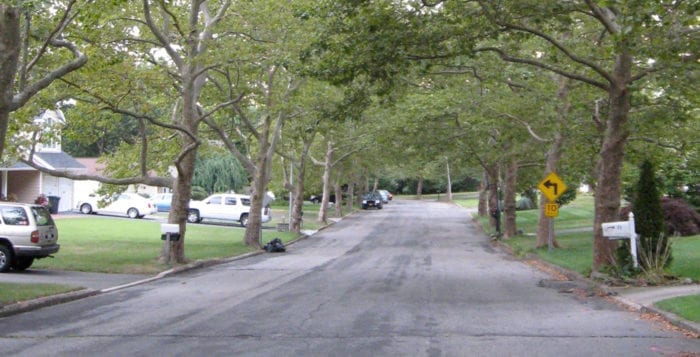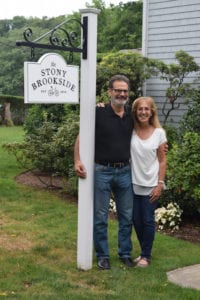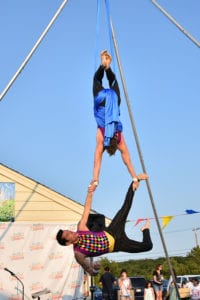No catch and release here:
Karen Silvestri of Melville recently captured this image of a juvenile black-crowned night heron fishing for its next meal at Avalon Park and Preserve in Stony Brook.
Send your Photo of the Week to [email protected].
No catch and release here:
Karen Silvestri of Melville recently captured this image of a juvenile black-crowned night heron fishing for its next meal at Avalon Park and Preserve in Stony Brook.
Send your Photo of the Week to [email protected].

By Wenhao Ma
One local organization is helping international students adjust to American life.
An evening reception was held at the Wang Center on the Stony Brook campus Aug. 25 to introduce new international students to their host families. For 40 years, the Stony Brook Host Family Program has been providing opportunities for international students to learn about America by having them develop relationships with local volunteer families.
“It’s very difficult when you are not really comfortable with the language,” said Rhona Goldman, director of the program. “This [program] gives students a chance — off campus — to relax and interact with a family.”
Students do not live with the families, but they are invited to join them for meals or to attend events together. Goldman said some families meet with their hosted students two or three times a year, while others see each other on a regular basis.
Goldman and her husband, Dick, are hosting two new international students this year, one from Ghana and the other from China.
“There are so many international students,” Dick said. “They come in not knowing anyone. So they will gravitate to people from their own countries. The dorms, classes, study groups — everything turns out that way.”
He said a lot of international students have a difficult time adjusting to the culture. For example, they don’t know how to get a driver’s license or open a bank account. A family can ease the transition and make finding their way a much more pleasant experience, he said.
“Rhona and her husband Dick are wonderful,” said Jianing Yan, a former hosted student of theirs who graduated in May. “They helped me adapt to the life in America. They took me to shopping malls and grocery stores on the very first day I arrived. Also they helped me learn about the American culture … They really make me feel comfortable here. To me, they are my family.”
Goldman said the students are not the only ones who have benefited from the program. The families benefit, too.
David Altman became a volunteer last year. He hosted three students last semester and will host another two this fall. He said that he has traveled with his daughter to many countries and is interested in different cultures.
“I’ve studied many languages myself,” Altman said. “I know a little Chinese. [The program] helps me also. So it works both ways.”
The host family program works with the university to send out a notification to all international students after they have been admitted. To become enrolled in the program, both students and host families need to submit applications. Goldman said she matches students with families that share similar interests.
On average, about 120 students a year are assigned to 65 local families. However, according to Goldman, this year many students could not be placed simply because there are not enough hosts. She encourages families to learn more about the program and consider becoming hosts.
“We want to serve as many students as possible,” she said. “It’s a most rewarding program.”
Brookhaven highway dept. says it will take a second look before removal

Two weeks ago, homeowners on Mosshill Place in Stony Brook were alarmed to find virtually every tree on their street — mostly sycamores — marked with pink dots. It came as a surprise — and a shock, according to Susan Ackerman, who feels the trees add so much to the neighborhood. She immediately called the office of Highway Superintendent Dan Losquadro (R) to inquire about the dots and said she was told they marked trees to be removed prior to road paving.
Ackerman said panic set in for her and her neighbors as they began to discuss the possibility of losing all the trees on the street and the ramifications that would follow.
“We didn’t know where to turn,” Mosshill Place resident Tom Caputo said. “Someone suggested we call News 12. Maybe if we got the story out, we’d get some help. We were surprised. [News 12] was down the next day and they brought Dan Losquadro.”
Ackerman said a paving project several years ago that resurfaced several of the “major” roads in the neighborhood — including Manchester Lane, Millstream Lane, Marwood Place, Millbrook Drive and Malvern Lane — was completed without the removal of any trees. She did not understand why the same process could not be used now.

For his part, Losquadro said he is just trying to do his job the right way.
“I have an extreme backlog of paving work, more than $100 million,” he said in a phone interview. “With an average annual budget of $15 to $18 million, I need to get the maximum life expectancy out of the roads I am paving. I have to make sure roads are done properly.”
Decades ago, there was no thought given to what species to plant and where to place the trees, Losquadro explained. As a result, the trees are right on the curbs, their roots intertwined with them. The superintendent said the tree removal is going to be a big expense, and he wished he could spend that money on road paving.
On her way to work, Ackerman said, she drove around the M section of the Strathmore Levitt houses in Stony Brook to tally the number of spray-painted dots on trees. By her count nearly 300 trees are tagged. She estimates that approximately 200 homes will lose trees.
In a letter to Losquadro resident Barbara Caputo listed a few of the benefits of trees she feels ought to be considered. Moderating heating and air conditioning costs, enhancement of property values, use by wildlife for food, shelter and nesting, and improving air quality and reducing pollution are among the reasons she listed trees help the community.
Losquadro said he had not planned to contact residents of the M section until he had assessed the situation, but the pink marks were noticed and homeowners are concerned.
In an Aug. 26 letter to affected residents Losquadro wrote, “Despite the markings you have seen, my staff and I are currently re-evaluating which trees must be removed to eliminate road obstructions and which can remain with repairs made to cracked or lifted curbing.” It went on to say that letters to all affected residents would be sent out shortly detailing the new recommendations.
Marian Guralnick is the original owner of a home on Mosshill Place.
“I’ve watched these trees grow for 50 years,” she said in a phone interview. “To lose them now that they form an aesthetically pleasing and beneficial canopy would be an ecological disaster.”

Frustrating dropped calls, undelivered text messages and slow loading web pages may soon be a thing of the past on Long Island if one U.S. Senator has anything to say about it.
U.S. Sen. Chuck Schumer (D-NY) submitted a list to wireless carriers of more than 200 ‘dead zones’ for cellular service on Long Island Aug. 25. The list was accumulated by Long Island residents identifying areas where frequent lapses in service occur to Schumer’s website over the course of several months. North Country Road in Port Jefferson and Setauket, Main Street in Northport, Route 25 in Smithtown, Shore Road in Mount Sinai and Hawkins Avenue in Stony Brook were among the North Shore locations residents pegged for spotty service according to a press release from Schumer’s office.

“When it comes to cell service on Long Island, these dead zones are proof carriers need to —quite frankly— raise the bar,” Schumer said in a statement. “A heavily populated region like Long Island shouldn’t be home to over 200 dead zones. Just a stone’s throw away from New York City and home to several universities, thousands of businesses and more, Long Island’s cell phone coverage must remain uninterrupted. Now that Long Islanders have submitted critical dead zones locations to my office, our wireless carries must make sure they are fixed. I will share these locations to carriers and am urging them to come up with a solution that meets the needs of both Nassau and Suffolk residents.”
Spokespeople from wireless carriers T-Mobile and AT&T did not respond to requests for comment regarding Schumer’s list. Andrew Testa, a public relations manager for Verizon Wireless’ northeast market, deferred questions regarding the Senator’s list of dead zones to international nonprofit CTIA — The Wireless Association, who has represented the wireless communications industry since 1984. CTIA spokeswoman Amy Storey declined to comment on behalf of any of their members, which include Verizon Wireless, AT&T, T-Mobile and Sprint.
One company addressed Schumer’s concerns.
“Sprint is committed to making sure Sprint customers have a great experience on our network and we’re investing to improve our coverage and reliability on Long Island,” company spokeswoman Adrienne Norton said in an email Aug. 26. “We share Senator Schumer’s goal of better service for Sprint customers and look forward to working with him to enact legislation that will reduce barriers to network deployment.”
Norton added that more Sprint cell sites, or towers should be expected on Long Island in the next nine months, which should improve service.
Schumer said lapses in cellphone coverage could create dangerous situations if GPS technology fails, and could deter business owners from setting up shop or tourists from visiting Long Island if problems persist. He called on wireless companies to come up with solutions to alleviate the issues.
By Katelyn Winter
In 1939 Ward Melville along with his wife Dorothy created a not-for-profit corporation, the Stony Brook Community Fund, later named The Ward Melville Heritage Organization, to maintain and protect the historical and sensitive environmental properties that he would deed to it over the coming years. 75 years later, the organization continues to thrive. I recently had the opportunity to interview Ms. Gloria Rocchio, president of The WMHO, in her office at the Stony Brook Village Center.
How did you get involved with the WMHO?
My husband and I moved here on Memorial Day in 1977, and we volunteered for the organization. Mr. Melville passed away on June 7, 1977. I looked out the window, and I asked myself, is everything going to change? So we volunteered for a year or so, and then my predecessor decided to retire. I wasn’t too interested in applying [for the position] because I was head of Long Island Convention and Visitors Bureau. My husband wanted me to, because he never saw me. I was traveling to Washington, Albany and all over Long Island. So I applied [because] after volunteering here for a couple of years, I thought I knew what should be changed. I told them what I thought at the interview, and as I was leaving, I thought, well I won’t be selected. And I was. 36 years later, here I am, and I love it.
So you’ve lived here since 1977?
Actually I’ve been coming here since 1959. My mother and I came here, and when I got married, it was the only place I wanted to live. [My husband and I] got married in Nassau County and we honeymooned at the Three Village Inn.
What do you love about being president of The WMHO?
Well, first of all, for the first ten years I worked for Mrs. Melville — she was president. She was a wonderful mentor; I learned everything from her. She guided me, she had a great sense of architecture, and she was just a very intelligent, brilliant lady. Every day is a challenge. When I hire people I always say you’ll never be bored again, and it’s true. It’s not for everybody, it’s 24/7, and I’m not a one-man band. I have a wonderful staff that’s very hard working and we have a board of trustees that are very interesting, community minded, selfless, dedicated, and many of the people in the community don’t know them but they’re there and we have many meetings throughout the year. I’m just happy to be here.
What do you love about Stony Brook Village, and what is your favorite season here?
Oh, I love it all, I can’t pick one over another. But season is probably the fall, it’s just beautiful. We own the wetlands, 88 acres of it, and [one day] Dr. [Erwin] Ernst and I took some elected officials to the Marine Conservation center in a boat. It was in October, and the grasses and the trees were so golden. It was [Ernst’s] idea to come up with a Discovery pontoon boat to go into the wetlands. It was so different than seeing it by land, and it has really amazed people. Twenty something years we’ve been doing it. I once got a call from a lady who said she wanted to “take that ride into the swamp.” The next day, she called and said, “I never knew anything about the importance of wetlands, and how they contribute to the ecosystem and the wildlife.” She said it was “phenomenal.” They’ve been giving us rave reviews ever since.
What is the story behind the portrait of George Washington that hangs behind your desk?
That’s a funny story, because for a while I didn’t know either. This is Mr. Melville’s office, and I’ve been sitting in front of this picture for 36 years. As the years went by, I started to understand why [it was there]. Mr. Melville purchased properties that had to do with early America and George Washington’s spy ring; he bought the Brewster House. He knew about that in 1942, and so he purchased the Grist Mill. All these things had to do with early America, and Mr. Melville was fascinated by George Washington and what he did, and I am too. I do a lot of research on the houses, and I learned that one of the Brewster’s was very involved in the construction of the King’s Highway, and that’s how I found out about Austin Roe. Now that’s the Heritage Trail. It’s all so important.
How is the ‘It Takes a Team to Build a Village’ exhibit going?
Very well. In fact, we had a reception fairly recently, and a lot of people came. The board said it’s so popular [that] we’re leaving it up as long as we can, because more and more people are finding out about it. We did this because it’s the 75th anniversary of the village, and most things that happened in this area came out of this organization. The archives are enormous. We started to look in boxes and we found an eight millimeter film. It said “The Village Dedication,” and we got it transferred so we could watch it. And son of a gun, it was a video of what Mr. Melville did on July 3, 1941! He had huge parades, and a beauty contest — which we wouldn’t do now. He dedicated the village from the balcony at the fire house. We thought we should do something like this, and we couldn’t do anything as grandiose as he did, but we had this nice little re-dedication on July 10, and it was great. Then we found extraordinary documents, and we’re hoping to get funding to work with Stony Brook University and the Frank Melville Memorial Library to digitize it all and create a website. It’s a huge undertaking but that’s what this has inspired us to do.
What would you say you are most proud of about your time with the WMHO?
One is the Walk for Beauty — 23 years, raising 1.3 million for breast cancer research. [Also] the Youth Corps — 20 years, putting through scores of children. We now have 69 children enrolled who will all know what Ward and Dorothy did here, and they can pay that forward and teach others. I’m proud of the Educational & Cultural Center we built, I’m proud of the Inner Court, where Crazy Beans is — that used to be storage sheds, and we converted them — and The Jazz Loft — I’m very proud of that.
Tell us what upcoming events you’re excited for people to enjoy.
Well, the website with the digitized documents is one. But we’ve also received a grant from the Robert D. L. Gardiner Foundation to do distance learning. What that means is that an instructor giving a lesson in, say, the Brewster House [in Setauket], would be filmed and onto the distance learning site so that people from around the world could learn about the rich history we have here. We already have the cameras installed in the Thompson House [in Setauket] and the Brewster House and we’re developing programs for them. One program should be ready this fall, and the other should be ready next spring. It’s very exciting.
Do you remember what your younger self wanted to be when you grew up?
It’s funny, I wanted to be an artist, and I was an artist, for a while. I went to Pratt College, went into that career, and felt too isolated — you painted alone. I like people. But this is kind of an art form, when you think about it. I worked for government, county executives for a while, but then got into, not events, but being head of promoting Long Island. It’s interesting; it’s definitely an art form, this place. Recently, I began to understand that Mr. Melville wanted us to live with history. We take it for granted, and we shouldn’t. It’s really a phenomenon, what we live with. This morning I got stopped by a resident who has lived here for a long time and she said, “I want to tell you, Gloria, that living here is like living in a park, it’s so beautiful. It’s just wonderful to have it this way.” And I told her, well, as long as we can, the organization plans to keep it that way. It gets more challenging with years. You try to respect the past, but we have to be current and relevant, and be receptive to change. That’s what we try to do.
If you had to pick an ice cream flavor to represent yourself, what would you choose?
Muddy boots! It’s from Latitude 121, it’s such a great flavor.
At the end of the charming and educational interview I had with Ms. Rocchio, she left me with a very inspiring piece of advice. It is a quote, originally by Kuan-Tzu from the third century BC. It is also part of the inscription on a plaque at the purple beech tree on the Stony Brook Village Green planted by Mrs. Dorothy Melville on her 88th birthday, and was incorporated into the speech given by Dr. Richard Rugen, chairman of the board of trustees of The WMHO, for the closing remarks of the 75th anniversary of Stony Brook Village July 10 of this year.
“If you plan for a year, sow a seed. If you plan for a decade, plant a tree.
If you plan for a century, educate the people.”
This simple quote compromises the heartfelt and dedicated mission of not only The Ward Melville Heritage Organization but of Ms. Rocchio herself.
Author Katelyn Winter is a rising junior at Muhlenberg College in Allentown, Pa., majoring in English and creative writing. She is from Stony Brook and hopes to one day work in the publishing industry.

Stony Brook Community Church, 216 Christian Ave., Stony Brook will host the 12th annual Vintage European Sports Car and Motorcycle Show on the lawn in front of the church on Saturday, Aug. 13 from noon to 4 p.m. This popular, free event, for all ages, will display a wide variety of interesting cars and motorbikes from all over Europe. There will be a People’s Choice vote for the best cars and bikes along with live music by the Barking Men and food and refreshments for sale. All proceeds go to the outreach of the church and the scholarship fund of the annual children’s Performing Arts Camp. Rain date is Aug. 14. For more information, call Malcolm at 631-751-1381.
Sandy Pearlman lived in Setauket, graduated from Stony Brook University
By Susan Risoli
Who wouldn’t want more cowbell? Samuel “Sandy” Pearlman — who may or may not have inspired the classic “Saturday Night Live” skit about the song “Don’t Fear the Reaper” — had a fever for living the creative life. The former Setauket resident, Stony Brook University alumnus, and celebrated record producer-lyricist-executive, died last week in California at 72. His friends remember a man whose imagination raced ahead while urging everyone else to keep up.
“He was a philosopher-king,” said Norm Prusslin, an SBU professor who first met him on campus in 1969, when Pearlman was managing a local band he called Soft White Underbelly. In this bunch of guys he met at his father’s pharmacy in Smithtown, Pearlman found musicianship that could turn his stories and poems into records. He loved to write about astrology, architecture, mythical figures and all manner of futuristic things, Prusslin recalled.
Blue Öyster Cult recorded “Don’t Fear the Reaper” in 1976. The song, written not by Pearlman, but by the band’s lead guitarist Donald Roeser a.k.a. Buck Dharma, was a track on the “Agents of Fortune” album recorded at New York City’s Record Plant. Pearlman co-produced the album. So … was he in fact the record producer parodied by Christopher Walken in the SNL skit?
Bassist Joe Bouchard said it’s possible.
“Sandy had that look, yeah,” he said, with a chuckle, of the leather jacket and dark glasses worn indoors.
“He was always very happy in the studio — excited to get the band to do their best.”
— Joe Bouchard
More important was Pearlman’s success at pushing artists to go just a bit further.
“He usually said he wanted more energy during recording,” Bouchard said. “He was always very happy in the studio — excited to get the band to do their best.”
Pearlman worked with other artists, producing the Clash’s breakthrough 1978 release “Give ‘Em Enough Rope.” He also produced the Dictators — a punk band many consider to be a sonic link between the Stooges and the MC5, and bands like the Ramones and the Sex Pistols — and he managed Black Sabbath.
Pearlman lived on and off in a house on Main Street in Setauket, a few doors down from the Emma S. Clark Memorial Library. Prusslin said he had been hired to teach philosophy at SBU, but plans were curtailed by the cerebral hemorrhage Pearlman suffered in December of last year.
Longtime friends Robert Duncan, and his wife Roni Hoffman, saw Pearlman often. Duncan said Pearlman was especially proud of “Imaginos,” a project started as a poem and turned into a song circle album.
Although Blue Öyster Cult played on it, “Sandy always referred to it as his ‘solo record,’” Duncan said. “I think he would say that was his crowning achievement, when that record came out.”
Pearlman was always “the smartest guy in the room,” Bouchard said. “He knew that if you just do a pop song, it’ll be gone in a year. If you do a song with a little more depth to it, it’ll have some staying power.”

To show appreciation for the wonderful efforts of the gardeners of the community, the Three Village Garden Club instituted a Street Garden Recognition Program 11 years ago. Residents of the Three Villages were invited to participate in this program, had to fulfill the requirements of using only living plant material and the garden had to be well-maintained and be pleasing to the eye.
Participants included Laura Nektaredes, Barbara DeBree, The Jazz Loft, John and Nancy DeBellas, Virginia Bushart, Anthony Isola, Julie Parmagiani, Glynn Mercep & Purcell, LLP, Innovative Nutrition, Karin Ryon, Janet MacDowell, Palma Sette, Aida Von Oiste, Kim Squartrito, Rita Scher, Mike Specht, Bob Bronzino, Jackie Kramer, Eileen DeHayes, Michele Matton, Mary and Bill Wilcox, Jeanette Reynolds, Jean Jackson, Gladys Belmonte and Ralph VonThaden.
Members of the garden club viewed the participant’s gardens, and those who qualified were invited to a Brunch Reception held on July 16, at the Emma Clark Library. At the reception, each participant received a plaque, which was designed by a member of the Three Village Garden Club, JoAnn Canino. Photos of the gardens were on display at the reception and will also be posted in the library during the month of September.
If you would like to participate in the street garden recognition program next year or recommend a garden in the Three Villages that you admire, applications will be available at the Emma S. Clark Library in the late spring of 2017. For more infor- mation on the Three Village Garden Club, visit www.threevillagegardenclub.org. The public is encouraged to visit the street gardens at the following locations:
22 Deer Lane, E. Setauket
24 Deer Lane, E. Setauket
11 Lodge Lane, E. Setauket
7 Stalker Lane, E. Setauket
42 Fireside Lane, E. Setauket
52 Fireside Lane, E. Setauket
2 Cedar Ave., E. Setauket
6 Van Brunt Manor Road, Poquott 6 Sharon Ave., Poquott
206 Route 25A, E. Setauket
5 Carlton Ave., E. Setauket
36 Lake Ave., Setauket
57 No. Country Road, Setauket
6 Wendover Road, Setauket
343 Main St., Setauket
15 Huckleberry Lane, Setauket
8 Huckleberry Lane, Setauket
15 Lewis St., Setauket
7 Mill Pond Road, Stony Brook
40 Main St., Stony Brook
275 Christian Ave., Stony Brook
139 Christian Ave., Stony Brook
16 Bailey Hollow Road, Stony Brook
8 North Road, Stony Brook
81 University Hgts. Drive, Stony Brook
Innkeepers have brought European bicycle culture to Long Island.
Marty and Elyse Buchman, who have been bicycling the world together for a decade, opened the Stony Brookside Bed & Bike Inn on June 1, located at 48 Main St., Stony Brook.
The couple set out to create a bed and breakfast that would cater to cyclists; providing not only sleeping space and a morning meal, but bike tour itineraries and even bikes, if needed, as well. Two months in, business has been much better than they expected.
“We’ve had people just looking for a place to stay — and that’s fine,” the husband said, indicating that not only cyclists have made up their clientele. A wedding party used Brookside for lodging recently.
The Buchmans have enjoyed bicycling in Europe because traveling by bicycle is considered normal there. It’s not just recreation; it’s a legitimate form of transportation, even for vacationers.
Their inspiration for a new kind of American bed and breakfast came during a 2010 bike tour of Italy. They booked a room in a “bike hotel” in Riccione on the Adriatic Sea. “Each day a guide came and took you for a different ride,” Marty said. “The idea was that you came back to the same place; and didn’t have to worry about navigating [your way] around.”

The following week they had a similar experience at Lake Garda in the mountains of northern Italy, this time staying at a “sports hotel.”
By vacation’s end, they had all the inspiration needed to start their own business.
When they first saw the colonial revival building at 48 Main Street, next to the Stony Brook Grist Mill and across the street from the duck pond, they decided it was perfect.
Built in 1941 by renowned architect Richard Haviland Smythe in a beautiful natural setting, it had the added advantage of being within walking distance of restaurants and shops, a museum and historical landmarks, a pond and nature preserve. It took perseverance, patience and negotiation skills, but they were able to purchase the house in 2014.
“This is an up and coming area for people to visit,” Marty said. “We’re always struck by how beautiful it is when we go on bike rides. People think they have to go out to the Hamptons or Sag Harbor. This is an undiscovered area. Just in the past year, [the opening of] the Jazz Loft and the Reboli Center, it seems like a lot of stuff is happening.”
The couple has done various kinds of marketing. The most effective, they said, was the simplest. A friend who runs a bike tour company put their business cards in every bike store in Brooklyn and Manhattan.
“It’s called a Bed and Bike Inn because it is a Bed & Breakfast, but oriented towards cyclists,” Marty said. “We have mechanical stuff. We have pumps. We have everything you might need for your bike. We have bikes, we have helmets; but most importantly, if you come to me and you say, ‘I want to do 20 miles and I want to see historic things,’ I’ve created a route book to provide just that. People can look through our ride book and decide what fits them.”
Elyse pointed out that each ride page gives you distance and elevation data in addition to the general route.
“Once a route is chosen, we print out turn-by-turn directions and we also provide a Garmin GPS which mounts on their bike and beeps when they have to make a turn,” Marty said. “I have lots of suggested routes — everything from 12 to 100 miles.”
Marty is a high school history teacher and said he would love to lead a local history bike tour. So far, though, no one has asked for that. Elyse noted that most guests have preferred self-guided rides, because then it becomes an adventure. “People tend to like to do that,” she said.
The house has three bedrooms, each with a private bath, and is open to guests seasonally. It will close Nov. 1 and reopen to guests on April 1 next year. For more information, call 631-675-0393.

More than 500 people stopped by West Meadow Beach last Wednesday evening for the three-hour Jewish Summer Festival.
Entertainment included an acrobatic performance by Cirque-tacular Entertainment, the music of Israeli singer Sandy Shmuely, face-painting and a moon bounce for the children.
That and a kosher barbecue dinner with all the fixings were part of the lure, but the bigger enticement was the camaraderie and friendship the festival offers.
The festival is a creation of Chabad at Stony Brook, and is co-directed by Rabbi Motti and Chaya Grossbaum.
“Seven years ago,” said Rabbi Grossbaum, “I was looking for a way to bring the community together for a public celebration of Jewish life, pride and future here in Suffolk County.” Now in its seventh year, it has become a midsummer classic event that many people look forward to.

The festival has grown every year, he said, gathering new partiers and sponsors as well.
“It’s nice to ‘hear’ your culture,” said Dominique Shapiro of Smithtown, referring to Shmuely’s music, “and to meet people—young, old, Jewish, non-Jewish—and also bump into those you know.”
Shapiro discovered the festival last year and brought her family again this year. Her three children played in the sand, sampled the food and swayed to the sounds of Shmuely’s guitar.
Steve Zalta of Holbrook attended with nine members of his family, including his two young granddaughters who, he said, danced away to the Hebrew music.
The 63-year-old sales rep of Syrian descent moved to Long Island from Brooklyn 30 years ago. He said at first, he used to go back to Brooklyn for Jewish content and connections; now, he has found outlets where he lives.
“We’re all one family,” he said in general. Of the summer event, in particular, “It’s a way for the children to see their heritage.”
Rabbi Grossbaum thanked the crowd for attending, and acknowledged the sponsors for helping make the night a success and bringing the community together. In fact, that’s what drew Elyse Buchman of Setauket to the festival for the second time.
“It’s very community-based,” she said. “No matter what temple you’re affiliated with—or none at all—you get together as a community and share in a good time. There are not a lot of places where you can do that.”
Buchman and her husband Marty are owners of the Stony Brookside Bed & Bike Inn, which opened in June and focuses on bike tours. She pronounced the North Shore “full of history and beauty that often falls under the radar.”
The icing on the festival cake was, as Shapiro noted, a very beautiful sunset, “one of the best on Long Island.”
